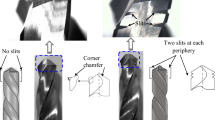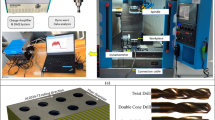Abstract
This paper focuses on the efforts for minimization of burr formation and improvement of hole surface roughness following machining of micro through-hole. The main idea deals with the development of a micro compound tool consisting of two different parts: a micro flat drill (drilling part) and a micro diamond-electroplated-tool (grinding part). The finishing diameter of each drilling and grinding parts are 90 µm and 100 µm, respectively. Furthermore, the study also focuses on the effect of entrance taper of grinding part, drill diameter and web thickness. The used wokrpiece was made of stainless steel (SUS304) with a thickness of 100 µm. From the experiment, it was found that the tool having entrance taper, drill diameter and web thickness of 10/100, 90 µm and 50 µm, respectively, shows the best performance in hole machining especially in burr minimization. Furthermore, the developed micro compound tool showed significant better surface roughness and burr minimization compared to usual micro twist drill and micro flat drill.
Similar content being viewed by others
References
Allen, D. M., Shore, P., Evans, R. W., Fanara, C., O’Brien, W., Marson, S., and O’Neill, W., “Ion Beam, Focused Ion Beam, and Plasma Discharge Machining,” CIRP Annals - Manuf. Technol., Vol. 58, No. 2, pp. 647–662, 2009.
Wang, D., Zhao, W. S., Gu, L., and Kang, X. M., “A Study on Micro-Hole Machining of Polycrystalline Diamond by Micro-Electrical Discharge Machining,” J. Mater. Process. Technol., Vol. 211, No. 1, pp. 3–11, 2011.
Li, M. S., Chi, G. X., Wang, Z. L., Wang, Y. K., and Dai, L., “Micro Electrical Discharge Machining of Small Hole in TC4 Alloy,” Trans. Nonferrous Met. Soc. China, Vol. 19,Suppl. 2, pp. s434–s439, 2009.
Opoz, T. T., Ekmekci, B., and Erden, A., “An Experimental Study on the Geometry of Microholes in Microelectric Discharge Machining,” Mater. Manuf. Processes, Vol. 24, No. 12, pp. 1236–1241, 2009.
Chern, G. L., Wu, Y.-J. E., Cheng, J. C., and Yao, J. C., “Study on Burr Formation in Micro-Machining using Micro-Tools Fabricated by Micro-EDM,” Precis. Eng., Vol. 31, No. 2, pp. 122–129, 2007.
Lee, K. and Dornfeld, D. A., “Micro-Burr Formation and Minimization through Process Control,” Precis. Eng., Vol. 29, No. 2, pp. 246–252, 2005.
Rahman, M., Asad, A. B. M. A., Masaki, T., Saleh, T., Wong, Y. S., and Kumar, A. S., “A Multiprocess Machine Tool for Compound Micromachining,” Int. J. Mach. Tools Manuf., Vol. 50, No. 4, pp. 344–356, 2010.
Wang, J. and Tang, X., “Analysis and Dimensional Design of a Novel Hybrid Machine Tool,” Int. J. Mach. Tools Manuf., Vol. 43, No. 7, pp. 647–655, 2003.
Imbaby, M. and Jiang, K., “Micro Fabrication of Stainless Steel Micro Components Using Soft Moulding and Aqueous Slurry,” Microelectron. Eng., Vol. 87, No. 1, pp. 72–78, 2010.
Aziz, M., Ohnishi, O., and Onikura, H., “Novel Micro Deep Drilling Using Micro Long Flat Drill with Ultrasonic Vibration,” Precis. Eng., Vol. 36, No. 1, pp. 168–174, 2012.
Ko, J. H., Shaw, K. C., Chua, H. K., and Lin, R. M., “Cusp Error Reduction under High Speed Micro/Meso-Scale Milling with Ultrasonic Vibration Assistance,” Int. J. Precis. Eng. Manuf., Vol. 12, No. 1, pp. 15–20, 2011.
Yang, I., Park, M. S., and Chu, C. N., “Micro ECM with Ultrasonic Vibrations Using a Semi-cylindrical Tool,” Int. J. Precis. Eng. Manuf., Vol. 10, No. 2, pp. 5–10, 2009.
Zhou, M., Eow, Y. T., Ngoi, B. K. A., and Lim, E. N., “Vibration-Assisted Precision Machining of Steel with PCD Tools,” Mater. Manuf. Processes, Vol. 18, No. 5, pp. 825–834, 2003.
Jhang, K. Y., “Nonlinear Ultrasonic Techniques for Nondestructive Assessment of Micro Damage in Material: A Review,” Int. J. Precis. Eng. Manuf., Vol. 10, No. 1, pp. 123–135, 2009.
Chang, S. S. F. and Bone, G. M., “Burr Size Reduction in Drilling by Ultrasonic Assistance,” Robotics and Computer-Integrated Manufacturing, Vol. 21, No. 4–5, pp. 442–450, 2005.
Liu, Y. J., Inamura, T., and Takezawa, N., “Effects and Possible Role of Atmospheric Molecules in Ultra-micro-cutting of Monocrystalline Silicon,” Precis. Eng., Vol. 30, No. 2, pp. 231–237, 2006.
Neugebauer, R. and Stoll, A., “Ultrasonic Application in Drilling,” J. Mater. Process. Technol., Vol. 149, No. 1–3, pp. 633–639, 2004.
Author information
Authors and Affiliations
Corresponding author
Rights and permissions
About this article
Cite this article
Aziz, M., Ohnishi, O. & Onikura, H. Advanced burr-free hole machining using newly developed micro compound tool. Int. J. Precis. Eng. Manuf. 13, 947–953 (2012). https://doi.org/10.1007/s12541-012-0123-2
Received:
Accepted:
Published:
Issue Date:
DOI: https://doi.org/10.1007/s12541-012-0123-2




